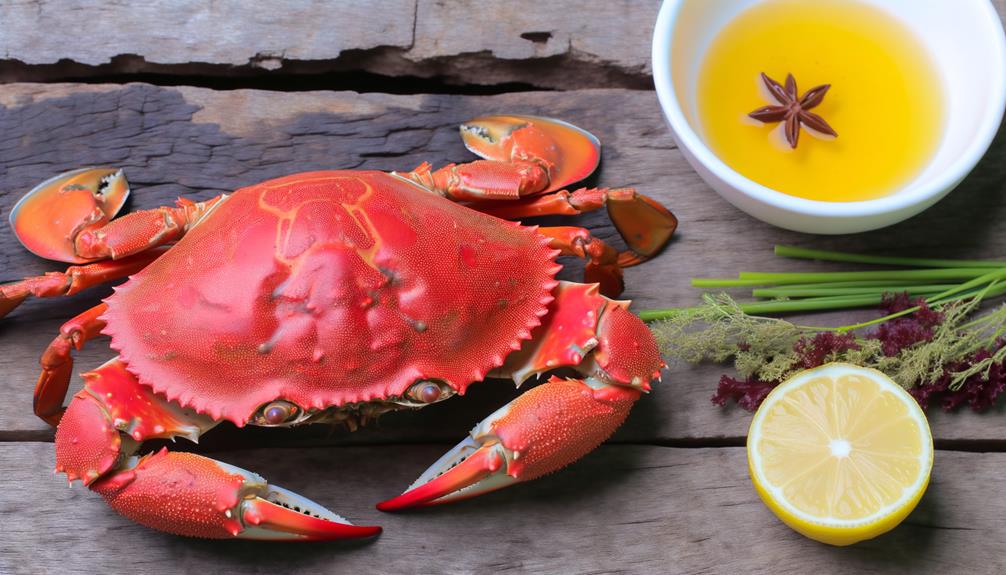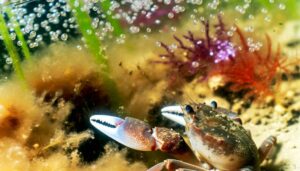How to Enjoy Mud Crab for Good Nutritional Benefits and Flavor
You’ll find Mud Crabs not only delicious but also nutritionally beneficial. Their meat is robust, sweet, and briny, offering an umami-rich taste due to their diet of mollusks, algae, and small fish.
They provide a valuable source of protein, omega-3 fatty acids, vitamins, and minerals, which support overall health and muscle repair. Cooking methods like steaming, boiling, grilling, and stir-frying preserve their firm, tender texture and enhance their natural flavors.
To enjoy them fully, select live, responsive crabs with intact carapaces and store them in a cool, moist environment. Discover recipes and sustainable practices for a truly satisfying experience.

Key Takeaways
- Mud crabs are known for their robust, succulent meat with a sweet and briny taste.
- They are a valuable source of protein, rich in omega-3 fatty acids, vitamins, and minerals.
- Cooking methods like steaming, boiling, grilling, and stir-frying enhance their natural flavors.
- Popular recipes like Chili Mud Crab and Mud Crab Curry highlight their distinct, savory taste.
- Prioritize buying live, active crabs with intact carapaces for the best quality.
Nutritional Value and Taste Profile of Mud Crab (Per 100g)
| Nutrient | Amount | Daily Value (%DV) |
|---|---|---|
| Calories | 120 kcal | 6% |
| Protein | 22 g | 44% |
| Total Fat | 3 g | 5% |
| Saturated Fat | 0.5 g | 3% |
| Cholesterol | 80 mg | 27% |
| Sodium | 290 mg | 12% |
| Carbohydrates | 0 g | 0% |
| Calcium | 50 mg | 5% |
| Iron | 1.6 mg | 9% |
| Vitamin B12 | 3 µg | 125% |
| Omega-3 Fatty Acids | 0.6 g | – |
Taste Profile of Mud Crabs
Mud crabs, known for their robust and succulent meat, offer a taste profile that’s both sweet and briny, making them a prized catch among seafood enthusiasts.
Their complex flavor results from their diet, which includes a variety of mollusks, algae, and small fish, contributing to their unique umami taste.
When you bite into a mud crab, you’ll notice the distinctive texture of its meat, which is both firm and tender. The high salinity of their coastal habitats enhances their briny notes.
These crabs thrive in estuarine environments, where freshwater meets seawater, creating a rich ecosystem that influences their intricate taste.
Understanding their ecological context helps you appreciate the complex interplay of factors that contribute to their delectable flavor.
Nutritional Benefits
Rich in essential nutrients, mud crabs provide a valuable source of protein, omega-3 fatty acids, and various vitamins and minerals that support overall health.
You’ll find that their high protein content aids muscle repair and growth, while omega-3 fatty acids contribute to cardiovascular health and cognitive function.
Mud crabs are also rich in vitamins such as B12, which is vital for maintaining healthy nerve cells and red blood cells.
Minerals like zinc, selenium, and iodine found in mud crabs play a pivotal role in immune function, thyroid health, and antioxidant defense.
Cooking Methods
For best flavor and nutritional retention, you can prepare mud crabs using several cooking techniques such as steaming, boiling, grilling, and stir-frying.
Steaming helps maintain their moisture and preserves essential nutrients like omega-3 fatty acids.
Boiling in seawater or a saline solution guarantees the crabs retain their natural saltiness, enhancing their umami profile.
Grilling imparts a smoky flavor while allowing excess fats to drip away, making it a healthier option.
Stir-frying, common in Asian culinary practices, quickly cooks the crab in high heat, preserving its texture and flavor while integrating other nutritious ingredients.
Each method offers unique advantages, ensuring that you enjoy both the ecological benefits and the delicious taste of mud crabs.
Popular Recipes
Explore some popular recipes that highlight the distinct, savory flavors of mud crabs while ensuring ecological sustainability and nutritional benefits.
Mud crabs, rich in omega-3 fatty acids and protein, are perfect for various culinary applications. Here are three recipes that you should try:
- Steamed Mud Crab with Ginger and Scallions: This method preserves the crab’s natural flavors and offers a nutrient-rich dish.
- Chili Mud Crab: A spicy, tangy recipe that balances the crab’s sweetness with the heat of chili, enhancing its complex taste profile.
- Mud Crab Curry: Incorporates aromatic spices and coconut milk, providing a comforting yet exotic meal that respects both flavor and ecological balance.
Buying and Storing Tips
When purchasing mud crabs, always prioritize selecting live specimens to guarantee freshness and excellent quality. Look for crabs that are active and responsive to touch, indicating vitality. Guarantee the carapace is intact and free from any signs of damage or foul odor.
For best storage, place live crabs in a cool, moist environment, such as a refrigerator crisper drawer, covered with a damp cloth to maintain humidity. Avoid submerging them in water, as this can deplete their oxygen levels. If immediate cooking isn’t possible, consider freezing cleaned crab meat.
Properly stored, mud crabs can retain their nutritional value and flavor, ensuring a delicious dining experience while respecting ecological sustainability.
Conclusion
You might find mud crabs to be a treasure trove of flavors and nutrients. With their delicate sweetness and robust texture, they offer a culinary experience that’s hard to forget.
Rich in essential minerals and low in unhealthy fats, they’re a boon for your health.
Whether you steam, grill, or stir-fry them, each method reveals unique flavors.
Just remember, when buying, opt for sustainably sourced crabs to keep our ecosystems in harmony.
Enjoy your delightful feast!






